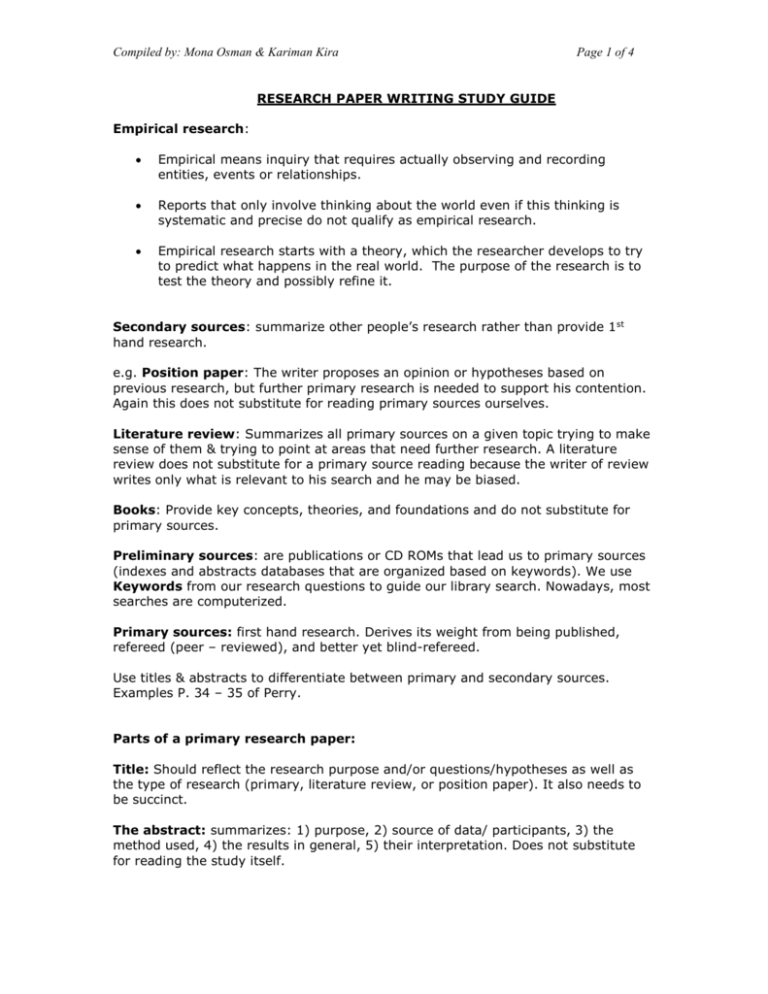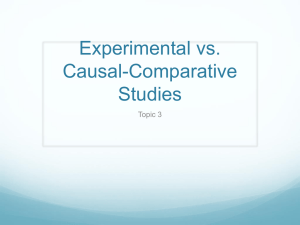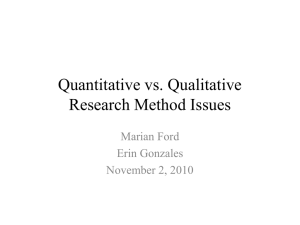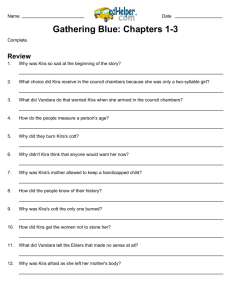Secondary sources: summarize other people*s research rather than
advertisement

Compiled by: Mona Osman & Kariman Kira Page 1 of 4 RESEARCH PAPER WRITING STUDY GUIDE Empirical research: Empirical means inquiry that requires actually observing and recording entities, events or relationships. Reports that only involve thinking about the world even if this thinking is systematic and precise do not qualify as empirical research. Empirical research starts with a theory, which the researcher develops to try to predict what happens in the real world. The purpose of the research is to test the theory and possibly refine it. Secondary sources: summarize other people’s research rather than provide 1st hand research. e.g. Position paper: The writer proposes an opinion or hypotheses based on previous research, but further primary research is needed to support his contention. Again this does not substitute for reading primary sources ourselves. Literature review: Summarizes all primary sources on a given topic trying to make sense of them & trying to point at areas that need further research. A literature review does not substitute for a primary source reading because the writer of review writes only what is relevant to his search and he may be biased. Books: Provide key concepts, theories, and foundations and do not substitute for primary sources. Preliminary sources: are publications or CD ROMs that lead us to primary sources (indexes and abstracts databases that are organized based on keywords). We use Keywords from our research questions to guide our library search. Nowadays, most searches are computerized. Primary sources: first hand research. Derives its weight from being published, refereed (peer – reviewed), and better yet blind-refereed. Use titles & abstracts to differentiate between primary and secondary sources. Examples P. 34 – 35 of Perry. Parts of a primary research paper: Title: Should reflect the research purpose and/or questions/hypotheses as well as the type of research (primary, literature review, or position paper). It also needs to be succinct. The abstract: summarizes: 1) purpose, 2) source of data/ participants, 3) the method used, 4) the results in general, 5) their interpretation. Does not substitute for reading the study itself. Compiled by: Mona Osman & Kariman Kira Page 2 of 4 Introduction: reflects: 1) the purpose of the study, 2) its significances, 3) the rationale behind needing this study which we tend to call review of the literature though it is not a comprehensive one as in a proposal or a study classified as a review of the literature; It rather gives the logic behind needing to do the study at hand supported by examples of previous primary research, 4) definitions of variables and constructs, and 5) the research questions/ hypotheses. Research questions: the core & the beginning of any research process Types: * what questions (correlation) (What phenomena are of importance, in what context do these phenomena occur, and what important relationships exist between phenomena?) * Why questions (causation) (Why do these phenomena occur, and why do people differ on certain traits?) * investigating relation does not imply causation. Not because I find a strong statistical correlation between eating ice-cream and increase in crime rate, can I say that if I prohibit ice-cream sales crime rates will drop because the reason (causation) behind both may be different (high temp that make people thirsty and more easily irritated). Therefore, correlation is not causation. Sources of research questions: - practical problems (personal experience and/or observation) - secondary sources (literature reviews end in suggesting research) - primary resources (to apply on a different population, and/or limitations & recommendations for further research in the conclusion section) A hypothesis is a proposed solution to a research question based on theory or on previous primary research that needs to be tested. The constructs are the key terms in the research questions and are defined by adopting or by adapting a definition by an authority in the field, or operationally by using an instrument to measure them. The operational definition is the way a term is defined in the study at hand for research purposes. Variables are the things that vary in a study. If they do not change, they are not variables. They have to be mentioned in the research questions/ hypotheses, and clearly defined in the study. There are several types. We focus on the most important two: Independent variables are variables of influence; they affect the change in the dependent variables. Dependent variables are the variables measured by our instruments and influenced by the change in the independent one. Methodology: reflects the sample, the research design, the data collection procedures/ the instruments used, and the procedures followed. The sample: the participants or the objects used in the study. The sample needs to be randomly selected and representative (reflecting all the characteristics of the Compiled by: Mona Osman & Kariman Kira Page 3 of 4 target population) in order to be able to generalize the findings to the target population. The sample size needs to be reasonable in order to be able to generalize. The research design varies according to the research questions. There are three continua for research designs: 1) Basic – Applied: Basic: Theoretical, dealing with foundation values underlying the practical applications. Applied: Practical, directly applicable 2) Qualitative – Quantitative: Quantitative: uses statistics to generalize from a sample to a population Qualitative: uses observation and verbal description deeply and personally involving the researcher and relies on expert analysis. 3) Exploratory – Confirmatory: Exploratory: No hypothesis, trying to find answers to the research questions. Confirmatory: involves an experiment to confirm a hypotheses Most studies are not purely one or the other, but are more tilted towards one side of the 3 continua. More on quantitative/qualitative continua Quantitative research: The aim of quantitative research is to determine how one thing (variable) affects another in a population. Quantitative research is all about quantifying the relationships between variables. Quantitative research methods collect numerical data (data in the form of numbers) and analyze it using statistical methods. Quantitative methods include experiments where researchers apply a treatment and measure results before and/or after it. Another method is surveys. Qualitative research: The aim of qualitative research is to provide a verbal description or explanation of the studied phenomenon. Qualitative research methods collect qualitative data in the form of text, images, sounds drawn from observations, interviews and documentary evidence, and analyse it using qualitative data analysis methods. Qualitative data analysis methods include case studies in which researchers conduct observations in a real world setting e.g. a software development project. The objective is for the researcher to immerse himself in the situation and gain a holistic understanding of the phenomenon in its natural setting. Another qualitative research method is action research where a researcher applies a research idea in practice and evaluates results. Data Analysis Quantitative data analysis: use of statistical methods to identify patterns and relationships in the data. Compiled by: Mona Osman & Kariman Kira Page 4 of 4 Qualitative data analysis: analysis is more subjective and relies heavily on the researcher’s knowledge and expertise to identify patterns, extract themes and make generalizations The instruments used are the data gathering procedures (surveys, tests, observation). Triangulation: is using more than one way of collecting data to increase the validity of the results. The material used is not the instruments but the stimulus used to prompt response. Validity is the degree to which a measurement/observational procedure accurately captures data and is used correctly. Reliability is the degree to which a data-gathering procedure produces consistent results. Procedures used details how the study was executed. The results are expressed statistically for quantitative studies and verbally for qualitative (observational) studies. The statistical significance of quantitative data depends on the p value which needs to be less than the .05 level. If the p level is higher than that it means the chance of error, or in other words, of the results happening by coincidence or for any reason other than that presented in the study is more than 5%. If the error chance is higher than 5%, the results are statistically insignificant even if the researcher claims otherwise. Statistical significance p-value The statistical significance of a result is the probability that the observed relationship (e.g., between variables) or a difference (e.g., between means) in a sample occurred by pure chance ("luck of the draw"), and that in the population from which the sample was drawn, no such relationship or differences exist. The higher the p-value, the less we can believe that the observed relation between variables in the sample is a reliable indicator of the relation between the respective variables in the population. Specifically, the p-value represents the probability of error that is involved in accepting our observed result as valid, that is, as "representative of the population." In many areas of research, the p-value of .05 is customarily treated as a "border-line acceptable" error level. Results that are significant at the p .01 level are commonly considered statistically significant, and p .005 or p .001 levels are often called "highly" significant. The conclusion relates the findings to the research questions/ hypotheses, as well as to previous research findings. It gives the practical implications of the findings Compiled by: Mona Osman & Kariman Kira Page 5 of 4 (more in session 2), the limitations (weaknesses) of the study, its strengths, and suggestions for future research. In session 1 statistical significance was highlighted. In session 2 practical significance is important. It may be statistically significant that when a school pays 50,000 $ to buy a new attendance software, students attendance will improve by 2% (at the p <.0001 level), but is it practical to pay 50,000 $ to increase students attendance by 2% not 20% or 30%. You have to have both types of significance for results to be of any use. Reference List Adapted from Perry, F.L. (2005). Research in Applied Linguistics: Becoming a discerning consumer. NJ: Lawrence Erlbaum Associates. Borg & Gall (1989) Educational research. New York: Longman. Locke, L; Silverman, S; & Spirduso, W (1998) Reading and Understanding Research











